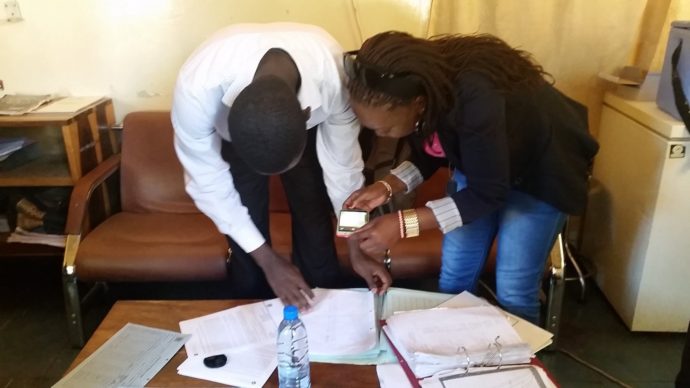What are the costs and benefits of implementation?
By Laura Di Giorgio, Health Economist & Mercy Mvundura, Senior Health Economist, BID Initiative
Aug 30, 2016
Posted in Monitoring & Evaluation

Photo: PATH. The BID Initiative team conducts a time use survey during an immunization session.
How much does it cost to implement BID interventions in the test sites in Tanzania and Zambia? What are the capital and recurrent costs of operating BID interventions? What are the resources required to implement interventions in each district? How do the costs of providing immunization services and reporting compare for the current system and after BID interventions are implemented? What are the benefits of the BID interventions that can be quantified in monetary terms?
These are some of the key questions policy makers and donors are asking the BID team as we move forward with implementing interventions in facilities in Tanzania and Zambia. This information will be used to make decisions about scaling interventions to other regions or provinces in the demo countries and for other countries who are considering adopting and adapting BID interventions.
To answer these questions, PATH health economists are leading an economic evaluation assessing both the financial and economic costs of implementing BID interventions in our demo countries. The financial costs are the monetary outlays for implementing the interventions while the economic costs include both the financial costs and also the opportunity costs of resources such as health worker time. The evaluation focuses on the costs and benefits to the ministries of health only and does not evaluate the benefits to children or their caregivers due to improved services and processes.
A key component of the economic evaluation is estimating the total cost of ownership of BID interventions (i.e., documenting the financial costs of the BID Initiative from the perspective of a ministry of health). These costs include all financial costs incurred by the Initiative to plan, develop, test, implement, monitor, and operate the interventions. The data to estimate the total cost of ownership are gathered from project records and also through tracking resources used by the teams who are implementing interventions. We are developing a separate total cost of ownership tool for each of our two demonstration countries. This information will be paramount for countries and donors interested in investing in similar health information systems.

Photo: PATH. The BID Initiative team takes photos of vaccine stock ledgers for the costing study.
In addition to the total cost of ownership, another key component of the evaluation is quantifying the economic value of all resources used for immunization service delivery at health facilities, and for reporting and stock management at the health facilities and districts. To achieve this, we are interviewing health staff using costing questionnaires to estimate the resources used for these activities from a sub-sample of health facilities and districts in each test site. We’re also conducting time and motion studies to determine the amount of time it takes health workers to deliver immunization services. We will then redo this assessment after BID interventions are implemented to have baseline and post-intervention data.
With data from both Tanzania and Zambia, we will also be able to explore the cost implications of the different approaches undertaken in each test site. In addition, the benefits in terms of savings, such as reduced labor time for registering and updating a child’s immunization card, or reduced vaccine wastage due to better demand forecast of vaccines, is estimated from the data collected and also through review of secondary data such as vaccine stock registers.
Developing a sustainable system is one of the cornerstones of the BID Initiative and plays a critical role in our success. The data gathered through the economic evaluation activities will help shed light on the total cost of ownership of BID interventions, and the impact, as measured through economic costs and benefits, of providing immunization services and reporting. The evidence will also highlight the main cost drivers of the interventions in each country and how the costs differ for different types of facilities (i.e., rural versus urban; small versus large volume) and different implementation strategies. The data collected will offer a critical piece of evidence for planning and continued sustainability of the interventions. When packaged with the outputs of other BID activities; countries, donors, and stakeholders will be empowered to make informed decisions to adopt interventions that can help improve immunization service delivery.
There is a dearth of evidence on the benefits and costs of health information systems interventions in low resource settings, and through the economic evaluation of the BID Initiative, PATH will provide an important contribution to this body of evidence.
